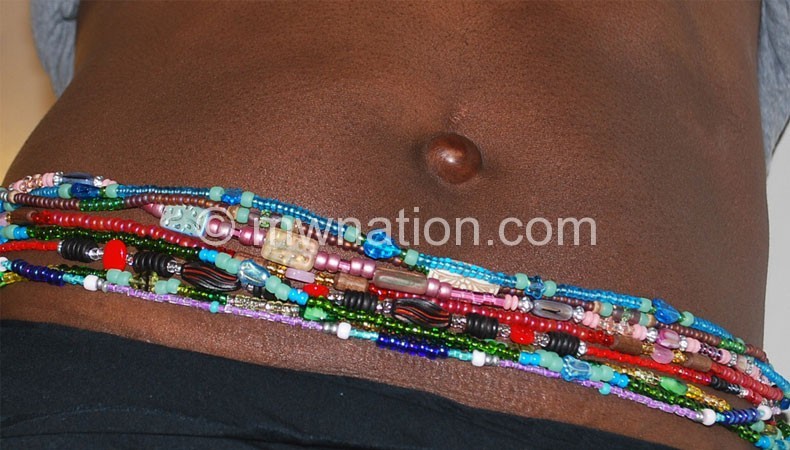No sex with a red bead on the waist

This is a fact. Beads (mikanda) are used as contraceptives.
Nonetheless, this should not be a surprise. In Malawi, beads form a better part of tradition.
In the rural setup, a traditional ceremony without beads is incomplete.
Think of initiation, traditional engagement and wedding ceremonies.
Even in music, those that claim to be traditionalists are incomplete if they leave out beads.
Music groups such as Fikisa have made their identity through use of beads to identify with tradition.
Success of love and relationships is not spared.
Village headman Makolosa of Blantyre says in the past, men used to shun girls or women without beads. He says beads were the first tool a woman who sought to get married was given by the elders for several purposes including contraceptive.
But today, the use of beads is declining and most females feel inferior to put on beads.
The reasons are as vast as they are personal.
But is society losing anything from the non use of beads?
Makolosa says foregoing some traditional beliefs has brought both positive and negative impacts.
He says some traditions have become irrelevant whereas others are worth maintaining.
He mentioned family planning methods which are bothering authorities at the moment, saying Malawi’s tradition has practices which, if used, can help to control the number of unplanned pregnancies especially in marriages.
“In the past, beads were crucial in marriages and were used as a communication tool. The woman used the beads to inform the husband that she is in her menses or not and the right time for sex. Abstinence was achieved through use of beads. Men were very respectful and could not force the woman to sex while knowing she is in her menses and this was the power of believing in traditions,” he said.
Today, we have heard of women complaining that their husbands force them to have sex while in their menses or when they feel they are about to.
“Women were taught about the time frame that can lead to their pregnancy and were advised to do sex in that time if they really want to become pregnant. They would put on a bead of a different colour and when a man sees the bead, he knew that doing sex at that time could lead to pregnancy,” said Makolosa.
The chief says there are common colours of beads which women use to communicate to their husbands about having sex.
“Every woman was supposed to have two strings of beads of different colours. One was red and the other white. Red means danger while white denotes safe for sex. There could be another colour which the woman would put on when she knew her menses were around the corner to inform the man of impending danger. These beads were hung in the bedroom and when a man thought about sex, he would not talk to the wife immediately, but check on the colours of the beads on the wall. If there was a red one on the wall then he could tell the wife he wanted sex,” explained the traditional leader.
Senior chief Kachindamoto of Dedza concurs with him.
She says beads have helped to promote peace and understanding in families.
She adds that they have protected women from unplanned pregnancies.
“There are some women who still use beads as a communication tool in marriage and I can challenge anyone that this has been successful because the man reads the story on the colour of the beads in the waist. Knowing that there is red colour kills the need for sex. It is different today and unfortunately, most women cannot verbally stop their husbands from having sex with them. Beads are safe because the communication is silent and complete. There is no tussling,” she said.
She added that women sometimes know when they can get pregnant and they put on the red bead to stop the man from having sex with her and in the process, controlling unplanned pregnancies,” she said.





